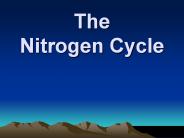Chemoautotroph PowerPoint PPT Presentations
All Time
Recommended
Unlike autotrophs and heterotrophs, the sources of Energy and electrons for ... oxidize ammonium ions (NH4 ) to nitrite ions (NO2-), and these they oxidize into ...
| PowerPoint PPT presentation | free to view
Isolation of an autotrophic ammonia-oxidizing marine archaeon2 ... Nitrification. FISH. Fluorescence in situ hybridization. Filter or preparation ...
| PowerPoint PPT presentation | free to view
Photosynthesis Photosynthesis in nature Autotrophs: biotic producers; make their own food photoautotrophs; chemoautotrophs Heterotrophs: biotic consumers; obtain ...
| PowerPoint PPT presentation | free to download
Photoautroph heterotroph chemoautotroph 2.1 Cellular Respiration: The Big Picture Overview of Cellular Respiration Process of Cellular Respiration Glycolysis ...
| PowerPoint PPT presentation | free to view
obligative (an)aerobe, heterotrophic, photosynthetic, chemoautotrophic, etc ... DNA fragments released by broken cells. b) Conjugation ...
| PowerPoint PPT presentation | free to view
carbon dioxide = auto. organic compounds = hetero. 5. Chemoautotroph. Energy source ... carotenoids, accessory pigments. chlorophylls. 15. Carotenoids ...
| PowerPoint PPT presentation | free to view
2. Use energy to synthesize cellular compounds from CO2 ... 3. Ferment glucose to ethanol, acetic acid, succinic acid . . . Anaerobic Chemoautotrophs ...
| PowerPoint PPT presentation | free to view
... chemoautotrophs; obtains organic food without eating other organisms ... biotic consumers; obtains organic food by eating other organisms or their by ...
| PowerPoint PPT presentation | free to view
Distinguish between photoautotrophs and chemoautotrophs. Describe the structure of a ... Thylakoids Flattened membranous sacs inside the chloroplast ...
| PowerPoint PPT presentation | free to view
Streams draining mine tailings are extremely acidic the effect of ... Hydrothermal vent fauna: a community founded on Thiobacillus a chemoautotrophic bacteria ...
| PowerPoint PPT presentation | free to view
Chemoautotrophic bacteria oxidize H2S which provides the energy for building organic molecules. ... What is being oxidized and what is being reduced in the ...
| PowerPoint PPT presentation | free to view
2. Desulfovibrio sp oxidize acetic acid to CO2 using SO4-2 ... 4. Soil aerobic chemoautotrophs oxidize NH4 to NO3- Aerobic Photoautotrophs ...
| PowerPoint PPT presentation | free to view
define the three roots of chemoautotrophs (chemo, auto, troph) ... substance that kills bacteria but should not be used on living surfaces ...
| PowerPoint PPT presentation | free to view
Rumen and reticulum - where symbiotic bacteria and protists break ... Abomasum - further digestion by cow's enzymes. Symbiosis. Autotroph-invertebrate symbiosis ...
| PowerPoint PPT presentation | free to view
Diseases: tetanus, botulism, gonorrhea, chlamydia, tuberculosis, etc., etc., etc. ... Diseases: tetanus, botulism, gonorrhea, chlamydia, tuberculosis, etc. ...
| PowerPoint PPT presentation | free to view
Water and Life * Last time we discussed the existence of water on earth between 3.5 and 4.4 billion years ago. This was during the precambrian which was the time the ...
| PowerPoint PPT presentation | free to download
Fig. 16-0a http://www.pbs.org/wgbh/nova/sciencenow/3214/01.html Fig. 15-2 Fig. 15-3a Fig. 15-3b-2 Monomers Formation of short RNA polymers: simple genes 1 ...
| PowerPoint PPT presentation | free to view
Prior to 1977 they were considered bacteria ... Facultative and Obligate Anaerobes and Aerobes. How do Archaea tolerate the heat? ...
| PowerPoint PPT presentation | free to download
They can build up complex organic substances such as carbohydrates from simple inorganic sources ... animals of humans. They can live on such compounds , ...
| PowerPoint PPT presentation | free to download
Energy Flow in an Ecosystem * * Energy Flow Energy in an ecosystem originally comes from the sun Energy flows through Ecosystems from producers to consumers Producers ...
| PowerPoint PPT presentation | free to download
Homeostasis metabolism
| PowerPoint PPT presentation | free to download
Water and Life Water and Life The oldest macroscopic evidence of life on earth are stromolites, produced by the activity of ancient cyanobacteria.
| PowerPoint PPT presentation | free to download
Organization of an anoxygenic photosystem in the bacterial membrane ... Methanogens may be autotrophic or organotrophic. obligate anaerobic archaea. Fermentation ...
| PowerPoint PPT presentation | free to view
The Nitrogen Cycle Now we will take a closer look at the Nitrification Process Nitrification is a biological process during which nitrifying bacteria convert ...
| PowerPoint PPT presentation | free to download
... via cotransport with Na+, and facilitated diffusion Enter the capillary bed in ... the tract organs Sensors respond to Stretching Osmolarity pH Presence ...
| PowerPoint PPT presentation | free to view
Natural Sciences 360. Legacy of Life. Lecture 4. Dr. ... Inquiry: Ask a question. Observation: Gather data. ... Let's digress a bit. Bacteria Archaea Eucarya ' ...
| PowerPoint PPT presentation | free to download
Heterotrophs: obtain energy from organic sources or from other organisms ... Food chain lengths are determined by # of trophic structures in a system ...
| PowerPoint PPT presentation | free to view
Biosynthesis of Macromolecules Anabolism - use energy (ATP) from catabolism - use carbon from sugars, lipids, proteins, or any other carbon source (xenobiotics) to ...
| PowerPoint PPT presentation | free to view
Title: talaroch07 Author: Laraine Powers Last modified by: LONNIE Created Date: 10/12/2003 3:06:06 PM Document presentation format: On-screen Show (4:3)
| PowerPoint PPT presentation | free to view
Excluding the last few decades, Carbon dioxide (CO2) levels in Earth's ... Answer- What is, photoinhibition ? Return to game board. Light intensity 400 ...
| PowerPoint PPT presentation | free to view
Energy flow in ecosystems
| PowerPoint PPT presentation | free to download
Produce specialized enzymes (extremozymes) that allow them to tolerate extreme conditions ... Denitrification occurs in waterlogged soils. Little oxygen available ...
| PowerPoint PPT presentation | free to view
Structural basis for assembly and sulfide binding in the 400kDa hemoglobin from the hydrothermal ven
| PowerPoint PPT presentation | free to view
Topic 2 Determine the general principles governing the organization of matter ... If you burn energy you must have a system to re-coup it. New proteins, new DNA, etc. ...
| PowerPoint PPT presentation | free to download
Title: Energy flow in ecosystems Author: Bessey Hall Mac Lab Last modified by: Norman Herr Created Date: 6/2/1998 8:41:43 AM Document presentation format
| PowerPoint PPT presentation | free to download
Prokaryotes evolved pigments to shield themselves from UV light ... when the seasons are extreme or when there is little variation between seasons? ...
| PowerPoint PPT presentation | free to view
... chlorophyll & can use energy directly from the sun Autotrophs An Autotroph is any organism that can produce its own food supply! Autotrophs ... Food Chain Simple ...
| PowerPoint PPT presentation | free to view
Bacteria Structure and Function Prokaryote & Eukaryote Evolution Cellular Evolution Current evidence indicates that eukaryotes evolved from prokaryotes between 1 and ...
| PowerPoint PPT presentation | free to download
Essential micronutrients such as Fe thought to limit plankton growth. IRONEX: will adding Fe to the central Pacific Ocean cause a bloom in Plankton? ...
| PowerPoint PPT presentation | free to view
Component of cytochromes and certain nonheme iron-proteins and a cofactor for ... Thiamine pyrophosphate (TPP) Thiamine (B1) Oxidoreduction reactions ...
| PowerPoint PPT presentation | free to view
Lecture 6 Chap. 6 What is an ecosystem? System = regularly interacting and interdependent components forming a unified whole Ecosystem = an ecological system; = a ...
| PowerPoint PPT presentation | free to download
rod shaped, Gram negative, lophotrichous. chemoheterotrophs. Pseudomonas ... Sulfolobus (hot springs of Yellowstone National Park) - oxidizes sulfur ...
| PowerPoint PPT presentation | free to view
Gram-negative bacteria generally more pathogenic than gram-positive bacteria: ... Decomposition of oil spills by soil bacteria. Metabolic 'factories': Organic solvents ...
| PowerPoint PPT presentation | free to download
Microorganisms Chapter 24 Bacteria
| PowerPoint PPT presentation | free to download
If extremophiles were found just under the surface, away from the ... Boron. Stars are different from each other in all of the following except: a) temperature ...
| PowerPoint PPT presentation | free to view
The Nitrogen Cycle Now we will take a closer look at the Nitrification Process Nitrification is a biological process during which nitrifying bacteria convert ...
| PowerPoint PPT presentation | free to download
Unit 3 Environmental Biology Understanding the interactions between organisms and their environment
| PowerPoint PPT presentation | free to download
Physiological processes that are essential to food webs ... Allochthonous. vs. Autochthonous. A stream food web. Algae and bacteria. Invertebrates ...
| PowerPoint PPT presentation | free to view
The kingdom Archaebacteria is relatively small, consisting of three main phylogenetic groups. ... Some are autotrophic - able to produce their own food. ...
| PowerPoint PPT presentation | free to view
Bacteria and Viruses Starr/Taggart s Biology: The Unity and Diversity of Life, 9e Chapter 22 Key Concepts: The simplest forms of life are bacteria Bacteria are the ...
| PowerPoint PPT presentation | free to view
Background Biologists have long organized living things into large groups called kingdoms. There are six of them: Archaebacteria Eubacteria Protista
| PowerPoint PPT presentation | free to download
... very hot, acid habitats of 60-80 and pH 2-4, like the photo of a 'Hot springs' ... Bacilli rod-shaped (bacillus) Spirilla spiral (spirillum) Respiration ...
| PowerPoint PPT presentation | free to view
Found in hot, acidic, salty extreme conditions. Eubacteria ... bacilli-rod shaped. spirilla-spiral. Classification of Monera. 2 cont.) By shape and number ...
| PowerPoint PPT presentation | free to view
Mutualists (bacteria and host both benefit) Unicellular, colonial, filamentous ... phototaxis: movement toward light. chemotaxis: movement to chemicals ...
| PowerPoint PPT presentation | free to download
CLASSIFICATION, BACTERIA, AND VIRUSES Biology Virus Viral Infections can take place in two ways- Lytic infection Lysogenic infection Virus Lytic Infection The virus ...
| PowerPoint PPT presentation | free to download
Ecology Energy Flow in Ecosystems
| PowerPoint PPT presentation | free to view
























































